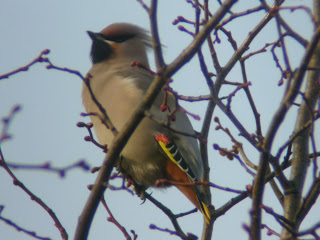First the ringing. As mentioned in my previous posting I spent as much time as possible going out with the Sorby Breck Ringing Group this year. In total I managed 45 trips out, handling a total of 447 birds of 38 different species. It's very difficult to pick put any highlights as far as species are concerned, as I'm still very excited to handle any bird, but I must say the Swallow roost at the Avenue back in August was very exciting as were the first pulli (5 Robins) at Linacre.
Robin pullus
As is to be expected in a land-locked county such as Derbyshire all the species I handled this year were passerines, with no sign of any waders or seabirds. In 2013 I need to continue with the "bread and butter" species such as Blue, Great Tit and the common finches and then gain some experience with some new species such as ducks, waders, seabirds etc... Keep reading to see what happens.
The other area I wanted to write about tonight was my attempt at "year listing", where I record all the species seen in a calendar year. At the start of the year I said I wouldn't go twitching for birds and so my total of 162 birds is quite respectable. The first bird of the year was Feral Pigeon, seen at 00.01 on 1st January in Trafalgar Square. My final bird, Waxwing, was seen back in November in Sheffield.
Waxwing
Next year, we're heading off to Menorca for a holiday, so there should be a few different birds in next year's list. Again, keep reading to find out what they will be.
My final words of 2012 are words of thanks. First and foremost to my gorgeous wife and daughter, who have not only accompanied me of several trips around the country, but, perhaps more importantly, have waited patiently for me whilst I've been out ringing and ticking. Thanks go also the Ray, my ringing trainer, and the other members of the group (you know who you are!) who have explained the intricacies of different birds' plumages to me over and over again and who have waited patiently for me to remember them. Thanks alot and here's to a happy, successful and enjoyable 2013 to everyone!


















































